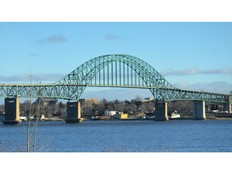N.B. faces economic ‘sugar high’ from population growth: expert
Economist warns of province’s growing trade deficit

Article content
With a population now topping 850,000, New Brunswick’s former chief economist is warning about the province’s ability to pay for increased services due to its growing trade deficit.
New Brunswick’s deficit topped $8.3 billion in 2022 after a relatively steady climb over the last 18 years, according to Statistics Canada data. Since a brief trade balance in the early 2000s, New Brunswick has been importing more goods and services than exporting to other provinces and countries, creating what’s called a trade deficit.
If exports exceed imports, it’s called a trade surplus.
The more goods and services New Brunswick imports, the more gross domestic product, labour income and tax revenue is sent outside the province.
David Campbell, New Brunswick’s former chief economist, has been sounding the alarm over the need for population growth and workforce development for more than a decade. He says his focus has now shifted to the province’s growing trade deficit.
“I’m more concerned about exports because if you don’t have an export economy, it’s almost like a sugar high,” said Campbell, president of Jupia Consultants Inc.
“You’re bringing people in, they’re bringing money in with them and they’re spending that money on household spending. But most of that household spending is going outside of the province to purchase goods and services (produced elsewhere).”
In 2022, New Brunswick imported about $30 billion worth of goods and services – everything from cars and movies to food and medical products – from other provinces and countries, while it exported about $22 billion.
New Brunswick is also seeing a greater reliance on income generated outside of its borders, according to fellow economist Herb Emery. That’s in part the result of remote workers, interprovincial commuters and retirees.
“In a lot of ways, what we’re really looking at is a transition in our economy from being a producer economy that is self-sustaining, to one that is a consuming province that is much more dependent on other regions of Canada to generate our income,” said Emery, who is the Vaughan chair of regional economics at the University of New Brunswick, in an interview.
If New Brunswick was in trade balance, that $8 billion would support $6.4 billion in gross domestic product, $3.7 billion in labour income and $1.1 billion in tax revenue for the province, according to calculations Campbell presented at a Canadian Manufacturers & Exporters conference on March 26.
That $1.1 billion would be enough to cover the salaries of all nurses and public school teachers in the province, pay for 95 per cent of the province’s 2024-25 capital budget, or cut the province’s need for federal equalization funding by 40 per cent.
Province faces ‘existential question’ about its economic future
However, Emery says he isn’t convinced the province is losing out on tax revenue because the money is coming in through federal transfers.
“Except,” he said, “I’m sure the province would like to have tax revenue plus the transfers.”
With its growing population, Emery says the province is facing an “existential question” about whether it should be concerned about its growing dependence on other regions of the country for income.
“There’s a lot of complacency with what we’re doing right now, but the big gamble going forward is we don’t control our fate if things go the other way,” Emery said, citing the slowdown of federal transfers in the 1990s that forced the province into austerity mode.
New Brunswick’s top export sector remains oil and gas, followed by the forestry and seafood sectors. Combined, these sectors generated $13.1 billion in export revenue in 2022, according to Statistics Canada data.
New survey data, however, shows that New Brunswick manufacturers were skittish in the first quarter of this year about expanding their businesses over the next 12 months. Only 1.3 per cent of surveyed New Brunswick manufacturers had local expansion plans compared to the national average of 10.7 per cent, according to Statistics Canada. Campbell says the province needs to send “clear signals” that companies can turn a profit here.
“We need to relentlessly focus on being a jurisdiction where companies make a decent return on investment.”












Postmedia is committed to maintaining a lively but civil forum for discussion. Please keep comments relevant and respectful. Comments may take up to an hour to appear on the site. You will receive an email if there is a reply to your comment, an update to a thread you follow or if a user you follow comments. Visit our Community Guidelines for more information.